 Aruna D’Souza
Aruna D’Souza
In the photographer’s current MoMA exhibition,
a reminder that war is never over.
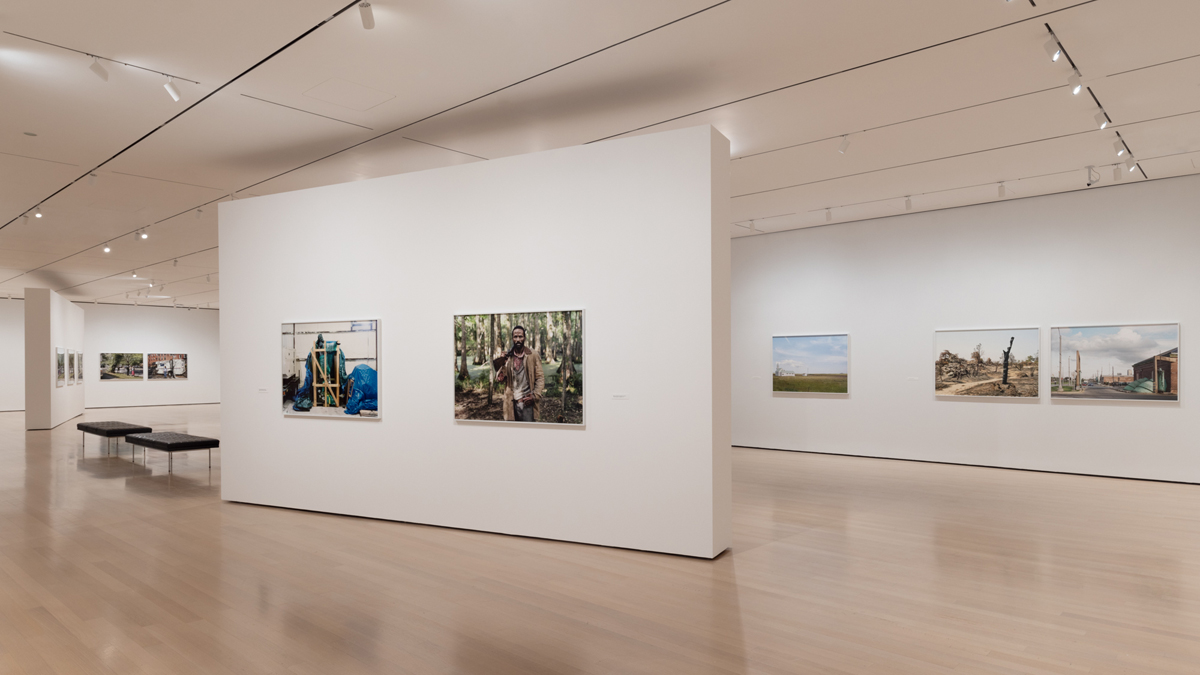
An-My Lê: Between Two Rivers / Giữa hai giòng sông / Entre deux rivières, installation view. Courtesy Museum of Modern Art. Photo: Jonathan Dorado.
An-My Lê: Between Two Rivers / Giữa hai giòng sông / Entre deux rivières, organized by Roxana Marcoci with Caitlin Ryan, Museum of Modern Art, 11 West Fifty-Third Street, New York City,
through March 9, 2024
• • •
Among the 145 photographs, textiles, films, and installations spread across eight galleries in An-My Lê: Between Two Rivers / Giữa hai giòng sông / Entre deux rivières at the Museum of Modern Art, one finds Ambush I, a gelatin silver print from her series Small Wars (1999–2002). The picture is hard to grasp—visually, but in other ways, too. In a forest whose tree trunks and foliage are rendered in almost preternatural detail, thanks to the five-by-seven view camera and wide-angle lens Lê prefers, we see men dressed in Vietnam-era soldiers’ uniforms, pointing guns in different directions, on the lookout for their unseen enemy. “See” is not quite the right verb—the figures’ movements, so quick they evade capture by the camera’s long exposure, turn them into ghostly apparitions, blurs that barely interrupt the landscape and oftentimes meld with it. And that landscape—that forest—is out of place: this is not the jungle that provided such effective cover for Viet Cong guerillas, leading US forces to eventually douse it with Agent Orange, an act of environmental and human devastation at once. Lê’s photo shows a location much tamer than that, a place you would go for a hike on Saturday if the weather were nice. It’s hardly the “living hell” in comparison to which “the bayous of Louisiana are like an English garden,” as a war correspondent characterized the actual Vietnamese countryside in a 1964 issue of the New York Times.
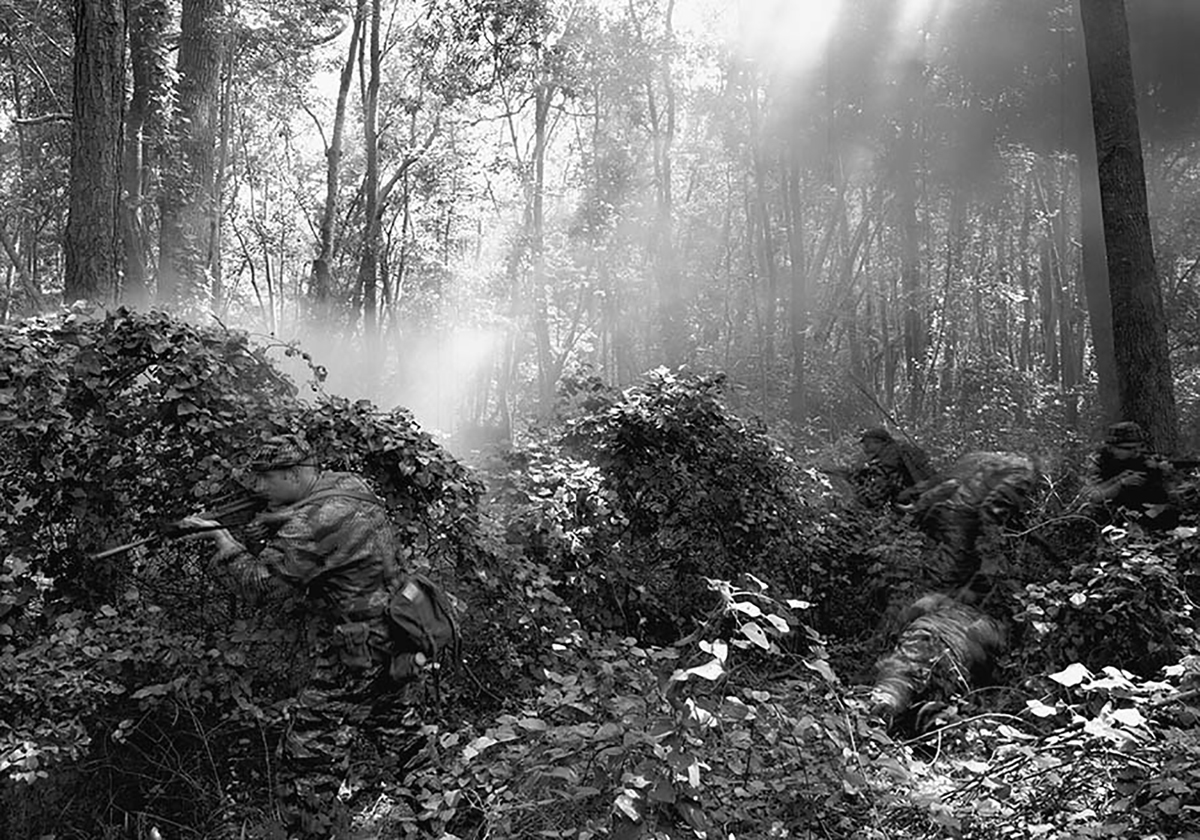
An-My Lê, Ambush I, from the series Small Wars, 1999–2002. Courtesy the artist and Marian Goodman Gallery. © An-My Lê.
The whole photo is an act of displacement—spatially, but also (given the dissonance between the date the photo was taken and what it seems to represent) temporally. Indeed, the artist, who was born in Vietnam in 1960 and came to the US after the fall of Saigon, has long been interested in displacement—especially how colonialism and its violence create diasporas, dislocate cultures, and trigger unsettling aftereffects that tend to go unnoticed. The rendering of the exhibition’s title in Vietnamese, (American) English, and French points to the intersection of forces that have shaped the modern history of Southeast Asia, while the two rivers to which it refers—the Mekong and the Mississippi—collapse the distance between Lê’s birth country, a projection screen for so many American fantasies of power, domination, and defeat, and the United States itself.
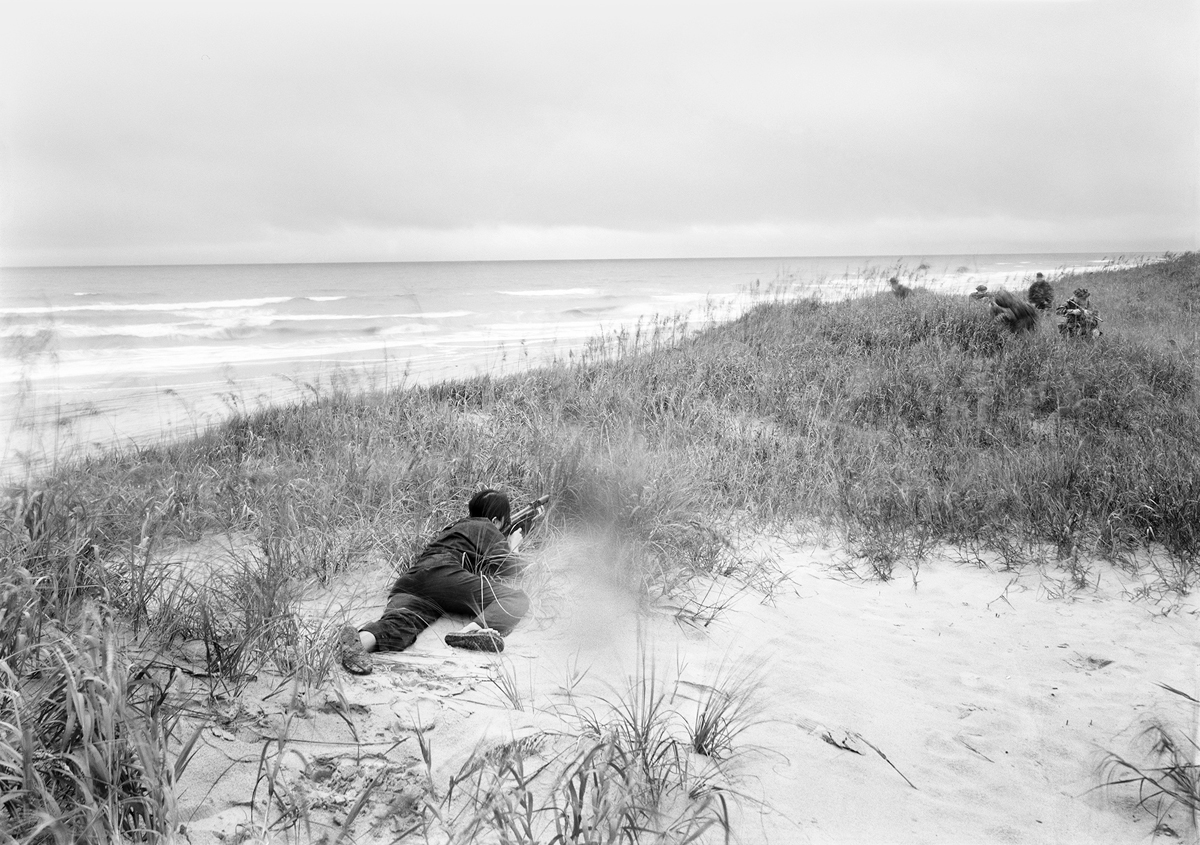
An-My Lê, Sniper II, from the series Small Wars, 1999–2002. Courtesy the artist and Marian Goodman Gallery. © An-My Lê.
Small Wars embodies one such form of projection. These images do not document the Vietnam War—they show its reenactment. To make them, Lê sought out enthusiasts—all white men—who gather in Virginia and North Carolina on weekends to game out skirmishes. Lê convinced them to let her take pictures; they said yes, as long as she agreed to participate in the role of Viet Cong guerilla. In Lesson, she sits, in a black uniform, on a log next to one of the cosplayers, teaching him Vietnamese during a lull in the action; in another, Sniper II, we see her from the back as she sprawls on a sand dune behind tufts of grass, aiming her rifle at “soldiers” in the distance. Like the simulated battles they portray, the images in Small Wars are carefully composed. In a five-minute black-and-white film that is part of the series, Lê’s camera catches the stiff self-consciousness of the men as they change their socks, signal to each other silently while on lookout, carry a casualty out of the line of fire, or look at girlie magazines. None of these actions appear natural to them—perhaps because they know they are being recorded, or perhaps because of the artificiality of reenactment itself.
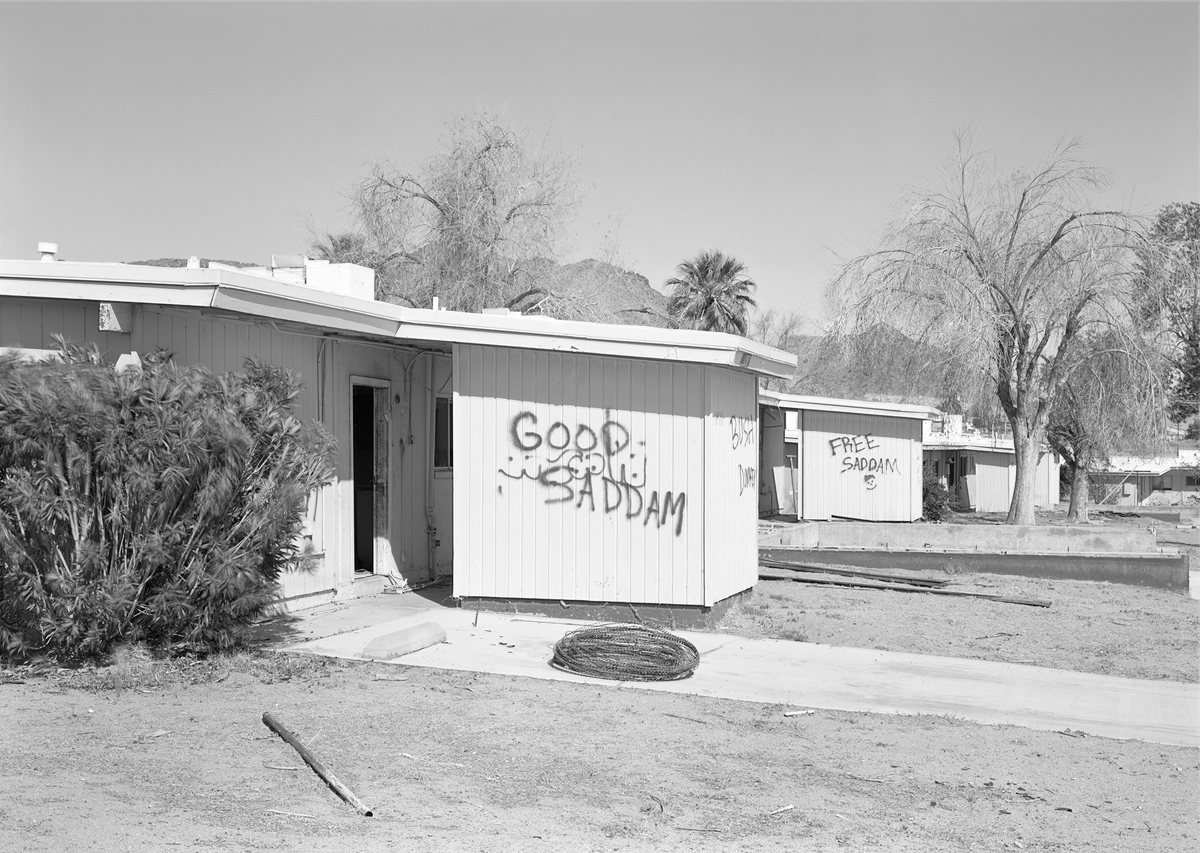
An-My Lê, Security and Stabilization Operations, Graffiti I, from the series 29 Palms, 2003–4. Courtesy the artist and Marian Goodman Gallery. © An-My Lê.
If such war games telescope the past into the present, the exercises we see in 29 Palms (2003–4) have a more futuristic timeline. Lê had hoped to get embedded with a regiment in the newly declared war in Iraq. Her request was denied, but she was invited to trainings in the Mojave Desert, a site the army chose to approximate the conditions soldiers would experience overseas. The film and photographs that make up the series have the same sense of theatricality as Small Wars, despite the change in context: this place is a stage set; these men and women are rehearsing. The film switches between long shots of detonations in the scrubby expanse, with its open horizon—the soldiers and vehicles look like ants here—and close-ups of the trainees’ mostly bored faces as they observe the plumes of smoke appearing in the distance. They are waiting in the wings for their cue. In some of the photographs, hilariously pedestrian graffiti adorns very American-looking bungalows, a simulacrum of where the fighters will soon be invading—“Good Saddam,” “Free Saddam,” “Go Home GI,” and ersatz Arabic writing. In another, a clutch of soldiers escorts a woman in a chador toward one of the houses while a bunch of “Iraqi” men gather to watch.

An-My Lê, Sailors on Liberty from USS Preble, Bamboo 2 Bar, Da Nang, Vietnam, from the series Events Ashore, 2011. Courtesy the artist and Marian Goodman Gallery. © An-My Lê.
War exists as an artifact of the past in Small Wars and preparation for an imminent future in 29 Palms. But it also suffuses the present in Lê’s work—we are constantly looking back or forward to war, or living through it, reiterating it, remembering it, even in spaces seemingly far removed from armed conflict. Events Ashore (2005–14) features the US Navy’s peacetime activities; Lê traveled on ships and submarines to capture sailors taking part in earthquake relief in Haiti, scientific activities in Antarctica, and other humanitarian missions. She makes their portraits and also photographs them having their portraits shot in an onboard studio. She shows them playing pool with a sexily dressed woman during their downtime in Da Nang. There is a slightly ominous quality to the pictures, perhaps because of the slow relentlessness of her camera’s gaze, its almost too-sharp focus, which underlines what Lê sees as the “fine line between coming to help and invading.” In Silent General (2015–ongoing), we find cadets graduating from the air force academy; shots of the film set from Free State of Jones, a historical war drama starring Matthew McConaughey; a bird’s-eye view of a vaccine site in Los Angeles taken early in the COVID pandemic; families trying to cross the Rio Grande; a pair of border officers—so alike they could be sisters—who guard opposite sides of the US–Mexico divide; and Confederate statues.
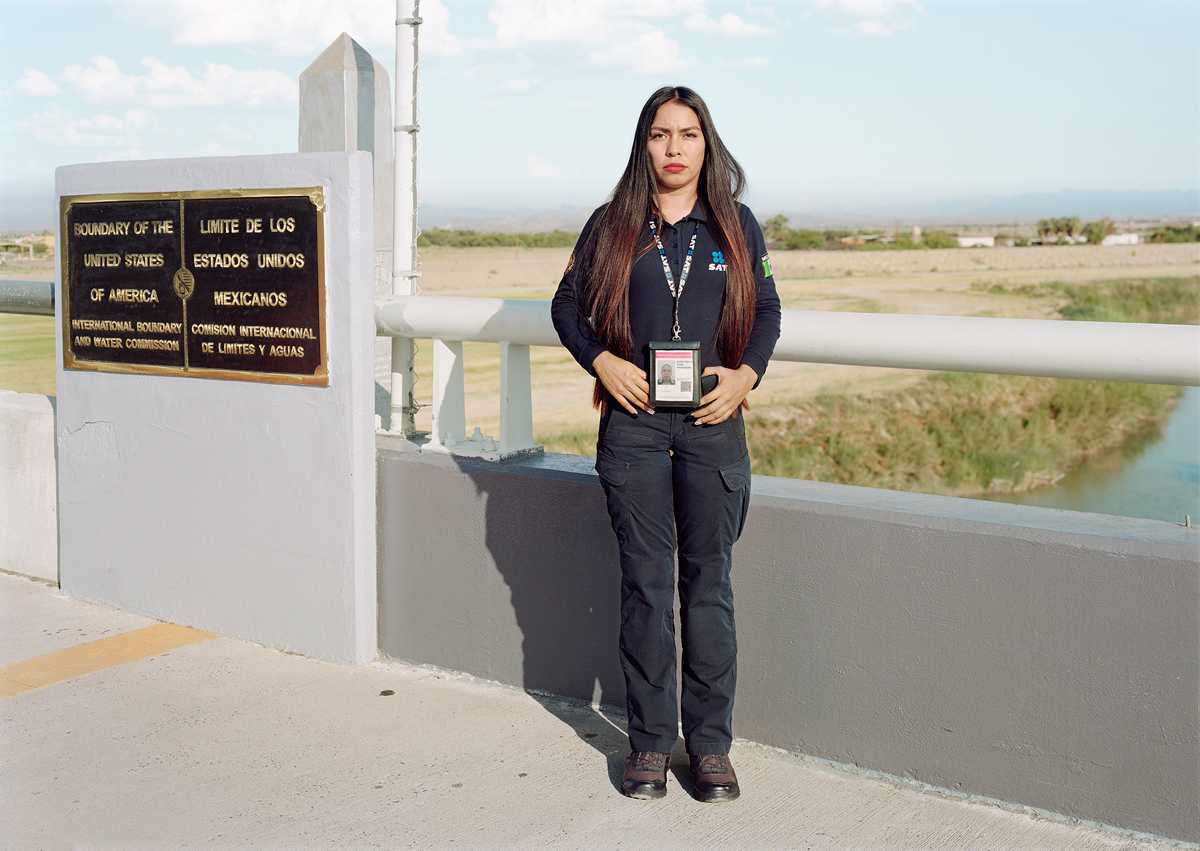
An-My Lê, Mexican Customs and Border Protection Officer, Presidio–Ojinaga International Bridge, Ojinaga, Mexico, from the series Silent General, 2019. Courtesy the artist and Marian Goodman Gallery. © An-My Lê.
Last year, I was at a dinner with a group of rich art collectors, including an economist. Someone asked him where the markets were heading, and he repeated the old saw that the US is living through the longest sustained period of peace and prosperity in modern history. I kind of lost my mind—name a decade, I growled, even a year, in which this country hasn’t been actively participating in invasions, “conflicts,” military operations, or proxy wars. I wish I had had Lê’s work at my fingertips in that moment, to push back on the idea that, just because bombs aren’t falling on our heads, we are living in peace. War is the very condition of life in the US, Lê clearly demonstrates—so normalized that the decision to enter into the next one gets easier and easier to make.
Aruna D’Souza is a writer and critic based in New York. She contributes to the New York Times and 4Columns, and is author of Whitewalling: Art, Race & Protest in 3 Acts (Badlands Unlimited, 2018). She is currently working on a new book, Seven Pictures for a New World, and a volume of collected essays.